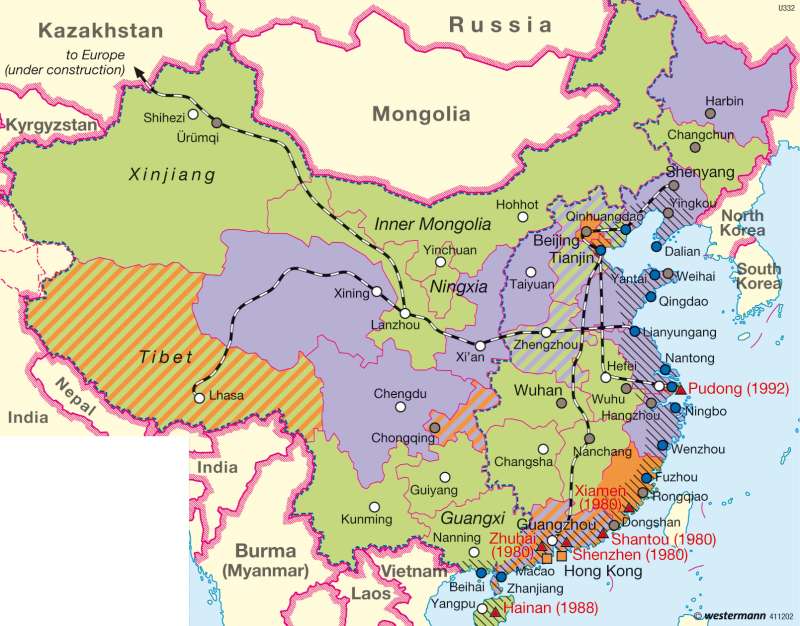China — Regional development since 1980
East Asia - Economy
978-3-14-100790-9 | Page 108 | Ill. 2

Information
China's impressive economic development began after the death of Mao Zedong. In 1978, Deng Xiaoping embarked on a reform course that ended the previous policy of economic isolation and opened the Chinese market to the western world. Economic promotion zones were mainly established on the coasts and the location there of foreign companies had been particularly encouraged. Today, the coastal region of China has recorded the strongest economic growth worldwide.The reforms were limited largely to agriculture but later were extended to industry and services. In 1992, the building of a "socialist market economy" as an objective of the reform policy had been defined. Since 1980, an important element of economic policy was the establishment of special economic zones along the coast and opening of coastal cities. Using these economic laws, other than those of the rest of China, foreign investors were offered the opportunity to invest and produce, and take advantage of low wages under world market conditions.
Development of the hinterland
While the booming cities spanned along China's southern and eastern coast, regions in central, western and northern China remained extremely backward. As a result, more people from the coastal provinces increasingly participated as migrant workers in the economic upturn. To counteract the development gap, numerous projects for the economic development of the rest of the country have started since the late 1990's. Through massive investments, the city of Chongqing was extended by the central government as an economic centre and is the starting point for the economic development of western China. With projects like "revival of the northeast" the central government attempted to direct investors to regions which until recently had received little attention.
Special Administrative Region of Hong Kong
At the beginning of the 19th Century, Hong Kong was a small fishing village on the southern coast of China. Due to the large, low lying, protected harbours, Hong Kong became one of the major trading centres of the Far East, with the status of a free port, in the latter half of the century. After 1945, Hong Kong became an important colony for British industry, specialising in cheap labour and mass production for the world market. Given the enormous population, China was growing as a supplier of raw materials with food and water increasingly more important. With this well established, many Chinese shops sold their goods to both the Hong Kong population and the many foreign tourists.
The political changes and the opening up of China in 1978, promoted economic recovery. Large parts of the labour-intensive manufacturing industries were relocated to China, especially in the neighbouring Shenzhen "Special Economic Zone" and the adjacent province of Guangdong. In 1984, China and Britain agreed as part of a "Joint Statement" that Hong Kong should allowed to remain a "special administrative region" for another 50 years.
After the handover of Hong Kong, which Britain had leased from China since 1st July 1898, for 99 years, a general feeling of uncertainty arose about the consequences of a possible economic decline. Several large companies moved their headquarters abroad and tens of thousands of highly skilled people migrated. On the other hand, many Chinese flocked from the People's Republic to Hong Kong. Nowadays, the economy of Hong Kong is back on the upward turn. With an average gross of nearly $30,000 (U.S.) per inhabitant in 2007, Hong Kong is by the World Bank positioning, among the strongest economies in the world today.
H. J. Buchholz, E. Astor; Ü: C. Fleming




